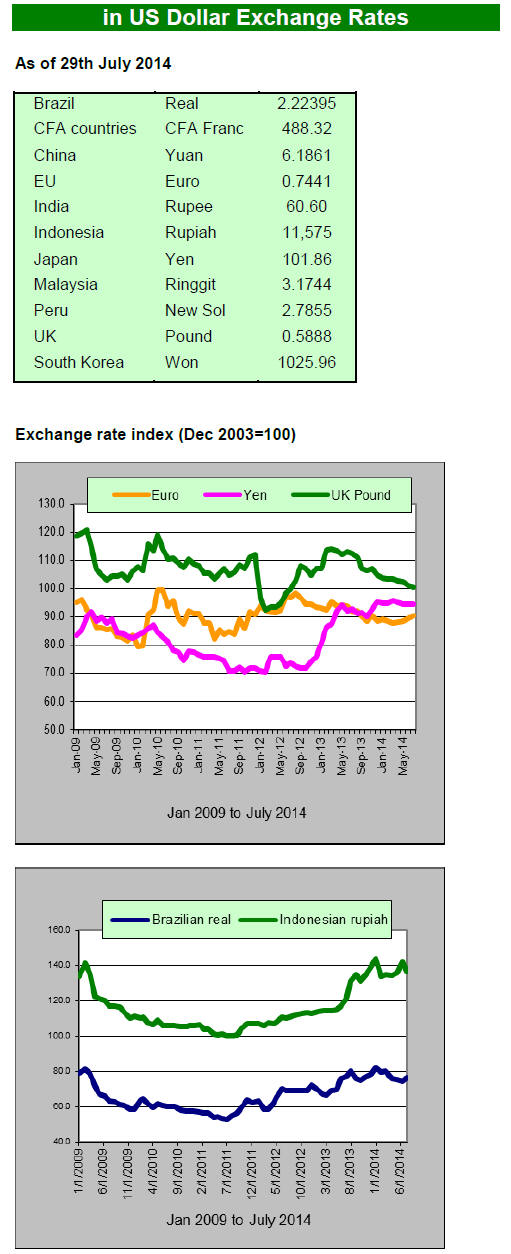2. GHANA
No further extraction of rosewood
The Outgoing Minister of Lands and Natural Resources,
Alhaji Inusah Fuseini, has confirmed that the ban
rosewood harvesting remains in force and has called upon
all Forestry Commission staff to be vigilant and halt the
illegal trade in Ghana rosewood.
A statement signed by the Minister revoked all permits
and licenses issued by the Forestry Commission for the
harvesting of rosewood, including permits and licenses for
the extraction and sale of rosewood from the Bui dam site.
Petrol subsidies removed
The National Petroleum Authority (NPA) has announced
an average 23% increase in the prices of petroleum
products as government subsidies have been withdrawn.
The manufacturing sector is now challenged with trying to
absorb some of the increase in production costs and
wherever possible pass on the cost increase to consumers.
Finance Ministry revises 2014 growth targets
The 2014 growth projections for Ghana‟s economy have
been revised down. The previously forecast GDP of 8
percent has been revised to 7.1 percent, while the end of
year inflation target of 9 percent has also been revised to
13%.
The government plan to cut the budget deficit from 12% in
2013 to 8.5% in 2014 has been thwarted, forcing the
government to set a new target to attain an 8.8% budget
deficit this year.
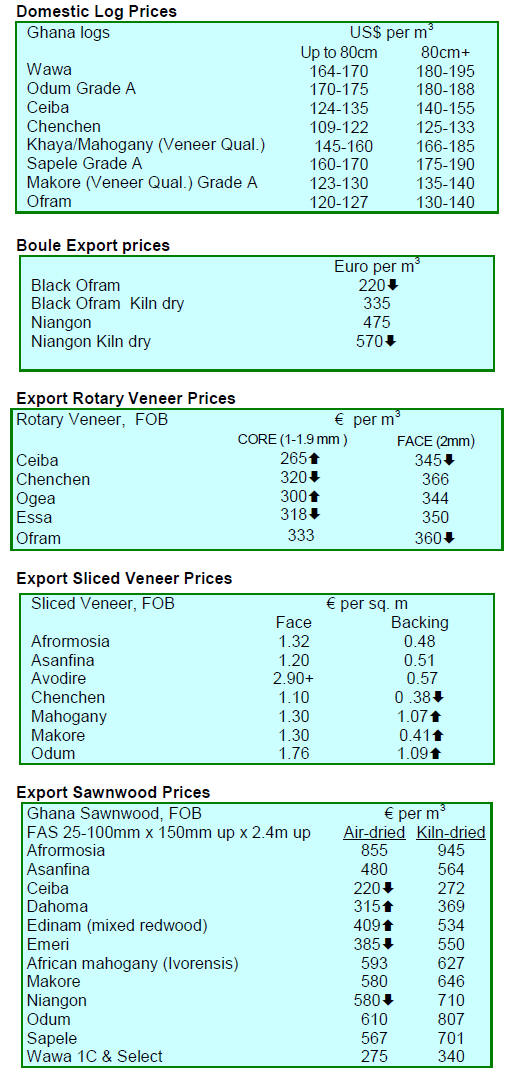
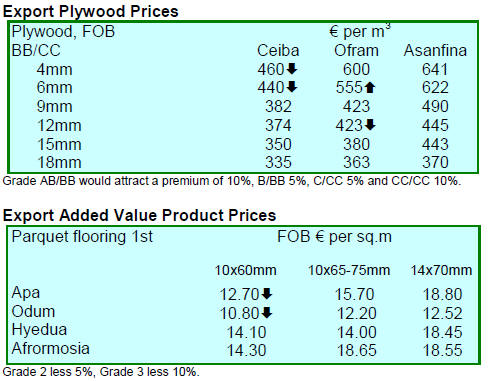
3. MALAYSIA
Epilogue - MTCS ※acceptance§ in Holland
The Malaysian Timber Certification Council (MTCC) has
confirmed that the PEFC-endorsed Malaysian Timber
Certification Scheme (MTCS) meets the Dutch
government‟s public procurement policy for timber.
The acceptance is for a period of two years and opens the
way for the Dutch timber and construction industry to use
Malaysia‟s PEFC-certified timber and timber products for
public projects.
Furniture industry needs to attract domestic workers
Malaysia‟s Plantation Industries and Commodities
Minister has said the government aims to rebalance the
distribution of foreign and domestic workers in the
country‟s furniture and wood working industries.
At present around 65% of the workers in the timber
industries are foreign and the aim is to increase the
proportion of domestic workers to about 70% by 2020.
The Minister said young people are not keen to work in
the industry which is perceived as tough with difficult
working conditions but mechanisation and automation is
changing the industry such that, with appropriate training,
it may be more attractive to domestic workers.
In related news, a study by the Malaysian Timber Industry
Board (MTIB) has forecast that, if the furniture industry
expands in line with government predictions, the sector
will require an additional 36,000 workers by 2020.
Sarawak plywood exports brace for impact of antidumping
duties
It appears certain that the South Korean government will
endorse the recommendation for an extension of the antidumping
duties on Malaysian plywood.
The anti-dumping duties were first imposed by S. Korea in
2011 and had a dramatic impact on Malaysia‟s plywood
exports to S. Korea as can be seen from the following.
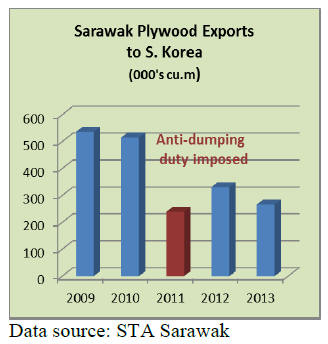
Sarawak plywood export prices
Sarawak plywood traders report the following export
prices.
Floor base (FB) (11.5mm) US$ 635 每 640 FOB
Concrete formboard panels (CP) 3‟x 6‟ US$ 560 FOB
Coated formboard panels (UCP) US$ 640 FOB
Standard plywood:
Middle East (9 每 18mm) US$ 480 FOB
South Korea (8.5 每 17.5mm) US$ 465 FOB
Taiwan P.o.C (8.5 每 17.5mm) US$ 465 FOB
Hong Kong US$ 460 FOB
4. INDONESIA
Timber trade deal with Australia
Trade Minister, Muhammad Lutf,i has revealed that
Indonesia and Australia are exploring the possibility of
creating a bilateral deal on trade in timber taking
advantage of Indonesia‟s legality assurance scheme
(SVLK).
Australia passed into law a Logging Prohibition Act in
November 2012 to eliminate imports of illegal wood
products. The authorities in Indonesia expect that the
SVLK will satisfy the new Australian law and could lead
to greater exports of wood and paper products to Australia.
Indonesia‟s main wood product exports to Australia are
paper, furniture and plywood and exports of wood based
products in 2013 totalled US$188.5 million which is
considered small in terms of the total demand in Australia.
Small timber enterprises need help with SVLK
The Center for International Forestry Research (CIFOR)
has released a report examining ''Timber Legality
Verification and Small-scale Forestry Enterprises in
Indonesia.
See: http://forests-l.iisd.org/news/cifor-seeks-to-improvelegality-
of-timber-from-small-enterprises/
The press release introducing the report says, ※There are
an estimated 700,000 small-scale forest enterprises in
Indonesia.
However, the SVLK (legality assurance scheme) has not
been broadly adopted by small producers and a high level
of illegal production takes place.
Some of the reasons for this lack of application among
small-scale enterprises include high certification costs and
limited verification and certification capacity§.
The report outlines some policy options and suggests
small operators be provided with financial and technical
assistance, that the process of certification be simplified
and that the number and capacity of verification bodies
(private sector organisations authorised by government to
offer SVLK certification services) be increased.
Boosting domestic consumption of locally produced
pulp
The Indonesian Pulp and Paper Association (APKI)
Deputy Chairman, Rusli Tan, has said his members found
it difficult to sell pulp into the domestic market as
domestic paper producers tended to focus on imported
certified pulp.
Indonesian pulp producers comply with the Indonesian
timber legality assurance scheme (SVLK) so APKI is
seeking government support for boosting domestic
consumption of local pulp. Because local producers of
pulp cannot sell into the domestic market they have to rely
on exports.
In related news the Ministry of Trade has identified the
market for Indonesian paper products in Pakistan to be
worth developing further. Currently India is the largest
market for Indonesian paper but Pakistan has potential
said Vice Minister of Trade, Bayu Krisnamurthi, as the
country‟s 2012 imports of paper and paper products was in
the region of 200,000 tonnes of which Indonesia supplied
less than half.
See: silk.dephut.go.id/index.php/article/vnews/90
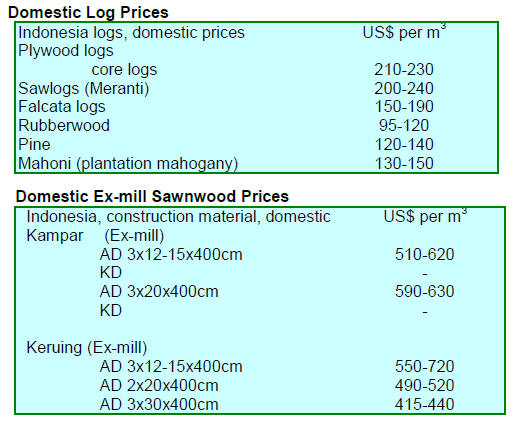

5. MYANMAR
Background to MTE sales
Open tenders by the state run Myanma Timber Enterprise
(MTE) are held by both the Export Department and the
Local Marketing Department.
The Export Department sells mostly teak and sales are
priced in US dollars, on the other hand, the Local
Marketing Department sells mainly non-teak hardwood
timber and their sales are priced in Myanmar Kyats
(MMK).
The Export Department open tenders are usually held
twice a month, one sale event for teak the other for nonteak
hardwoods when they are available. Buyers say that
currently the volume of logs is small at the Export
Department tender sales.
The Local Marketing Department sales are mostly of sawn
non-teak hardwoods and they held across the country
where ever there are MTE sawmills and depots.
Timber purchased from the both the Export and Local
Marketing Departments can be further processed and
exported.
Many of the companies having stocks of logs that missed
the 31 March shipping deadline for export are engaging
local mills to process these logs so the timber meets the
criteria for export.
Prices achieved at the 19 June open tender sale by the
MTE Local Marketing Department in Toung Oo Area,
Bago Division (East) are shown below.
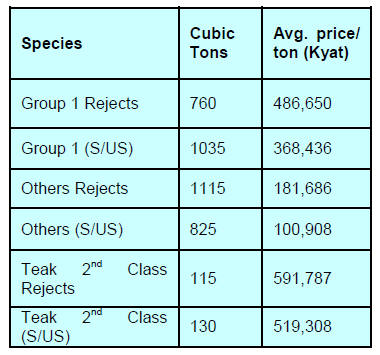
Group 1 includes mainly Pyinkadoe, Thitya, Ingyin,
Others include various species of non-teak hardwoods
other than Group 1.
S= Short lengths= 3' to 9.5'
US= Ultra Shorts= 1.5' to 2.5'
The above length group system is used by the MTE Local
Marketing Department when selling non-teak sawnwood.
In selling teak sawnwood the MTE Local Marketing
Department uses the same nomenclature as is used in the
Export Marketing Department i.e.: L= 6' & up, S= 3' to
5.5' and US=1.5' to 2.5'
The current price per ton for sawn teak and other
hardwoods in Yangon is MMK 2,200,000 to 2,300,000 for
teak and MMK 1,200,000 for Pyinkado per ton. Kanyin
sawnwood is trading at around MMK 670,000. These
prices are quoted for the domestic construction sector.
Vietnam to invest in manufacturing wood products
Vietnam has expressed interest in setting up an industrial
zone in Myanmar to process wood products and gems
according to the local Eleven Media Group.
Myanmar officials said they would welcome such an
investment in line with the country‟s Foreign Investment
Law. Currently, Vietnam is the eighth largest source of
foreign investment in Myanmar.
Myanmar‟s imports from Vietnam include
pharmaceuticals, cement, chemical products, machinery,
electrical products as well as paper, rubber and plastic.
Myanmar‟s exports to Vietnam include teak and other
hardwoods and minerals.
The following prices were obtained during the
Special
Open Tender sales held in Yangon on 25 July 2014.
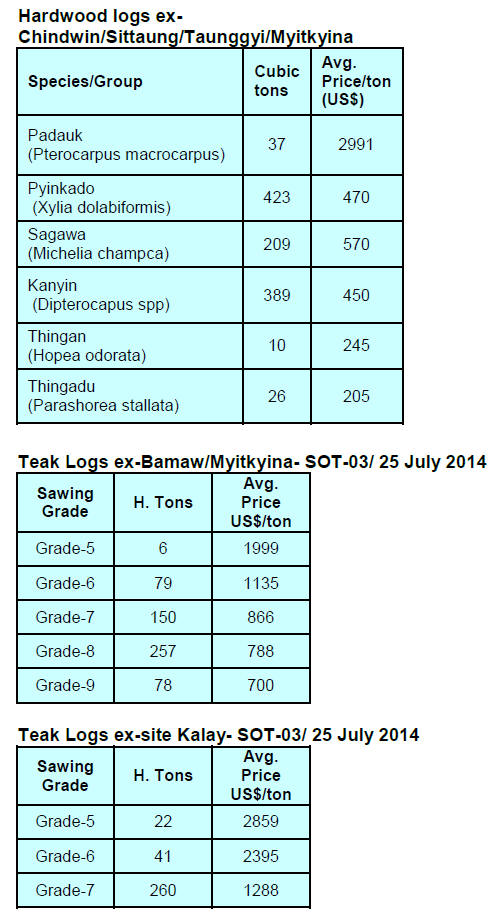
6.
INDIA
Smart cities 每 Singapore invited
to help
While there is no simple definition for smart cities, the
Smart Cities Council describes them as ※urban space that
is ecologically friendly and technologically integrated and
utilises information technology to improve efficiency‟. See
http://smartcitiescouncil.com/india.
Smart cities are necessary in India say advocates as India‟s
urbanisation is developing such that around 500 million
Indians will be living in cities by 2030, almost double that
at present.
In a recent study the McKinsey Global Institute says that
by 2030 the urban areas will provide the bulk of new jobs
and that almost three quarters of India‟s GDP will be
generated by the city workforce.
In related news, during a meeting with visiting
Singaporean Minister for Foreign Affairs, Singapore was
officially invited to contribute to the Indian government
effort to provide low-cost and affordable housing.
Economy on sounder footing
India's exports grew by more than 10% in June, the second
monthly rise and the latest sign that international markets
are firming which will put the Indian economy on a
stronger foundation. Imports also rose by over 8%
reversing the decline in May.
India's industrial output in June was at a 19 month high
and efforts by the Reserve Bank of India to stem consumer
inflation are taking effect as inflation dropped to the
lowest in two years.
The only negative news is that gold imports jumped 65%
in June to US$3.1 billion creating a risk that the currentaccount
deficit could widen so it is unlikely that the
government will relax the import tax on gold.
Pace of inflation growth slows
The Office of the Economic Adviser (OEA) to the Indian
government provides trends in the Wholesale Price Index
(WPI). The official Wholesale Price Index for All
Commodities (Base: 2004-05 = 100) for the month of June
2014 rose by 0.5 percent to 182.6 (provisional) from 181.7
(provisional) for the previous month.
Indian inflation slowed in June as food prices eased and
the forecast for a good monsoon resulting in high crop
yields is boosting confidence that the slowing pace of
inflation can be sustained.
The annual rate of inflation based on the June WPI was up
5.3% compared to the previous month See
http://eaindustry.nic.in/cmonthly.pdf
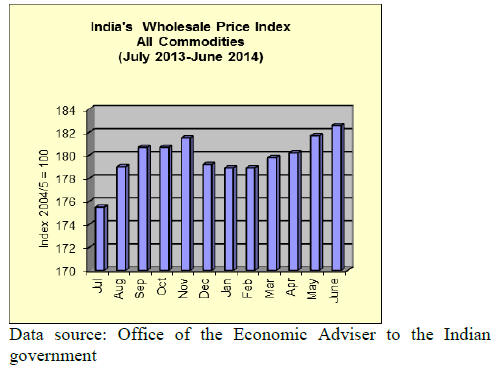
Timber and plywood wholesale price indices
The OEA reports Wholesale Price Indices for a variety of
wood products. The Wholesale Price Indices for
Logs/timber and Plywood are shown below. The June
2014 logs/timber index remains flat and for the first time
in six months the plywood price index dipped in June.

Domestic teak logs attract better prices
During the past auctions at Rani Amba, Raj Pipla and
Valsad forest depots in the Dangs Division, good quality
log lots were available from the Forest Worker‟s Cooperatives.
These logs attracted prices of Rs.100-150 per
cubic foot more than log lots from the Forest Department.
Average prices recorded at the most recent auction are as
follows:
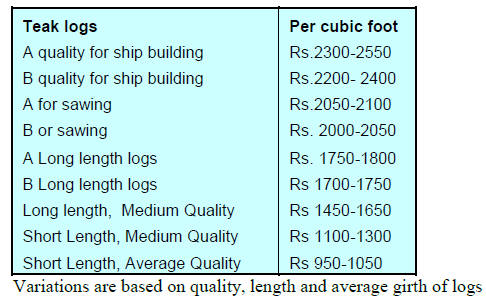
Good quality non-teak hardwood logs of Haldu (Adina
cordifolia), Laurel (Terminalia tomentosa), kalam
(Mitragyna parviflora) and Pterocarpus marsupium, 3 to 4
metres long having girths of 91cms and above attracted
prices in the range of Rs.750-950.
Medium quality logs of the same species were sold at
between Rs500-600 per cubic foot. The lower quality logs
went around Rs.300-~450 per cft.
The monsoon has become well established in those areas
so auctions will resume in the dry season which begins in
about three months.
Teak sales in Central India forest depots.
Over 20,000 cubic metres of teak logs were sold at
Timarni, Khirakia, Ashapur, Narmada nagar, Betul and
other depots in Central India.
As the volume of teak offered for sale Maharashtra
is
falling auctions in Madhya Pradesh also attract sawmill
owners from the Nagpur area.
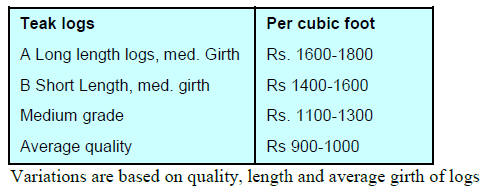
Approximately 15-20% of the log lots offered at the
latest
sale remained unsold as the reserve prices were not
achieved.
Plantation teak prices
Prices and deliveries for imported plantation teak are
reported as satisfactory. The slight weakening of the rupee
has had little impact on trade so far. Sales of plantation
timbers tend to slow during the monsoon.
Importers have noticed that imported log parcels now have
a higher proportion of small diameter „thinning poles‟ than
previously and this has resulted in the minimum price
offered for log parcels falling.
Current C & F prices for imported plantation teak, Indian
ports per cubic metre are shown below.
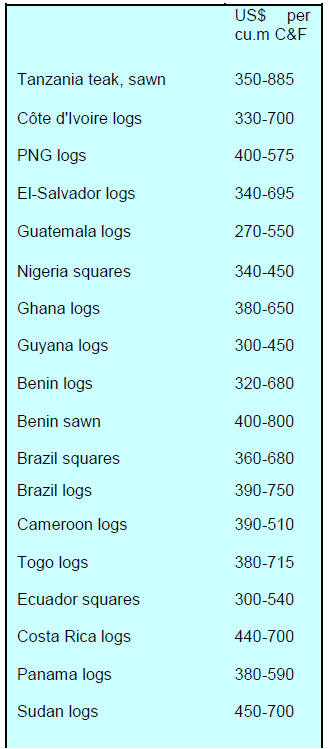
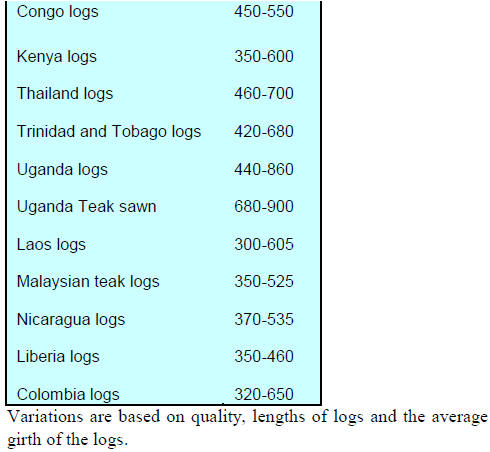
Prices for air dry sawnwood per cubic foot,
ex-sawmill are
shown below.
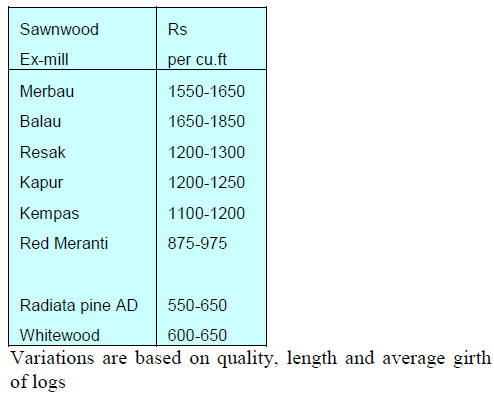
Myanmar teak processed in India
Current prices for air dried Sawn timber per Cubic Foot,
ex-Saw Mill, have remained steady and are as under:
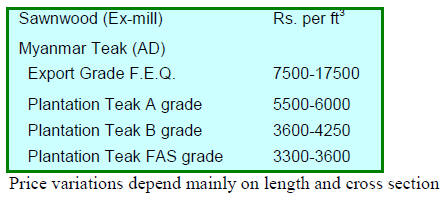
Imported sawnwood prices
Ex-warehouse prices for imported kiln dry (12% mc.)
sawnwood per cu.ft are shown below.
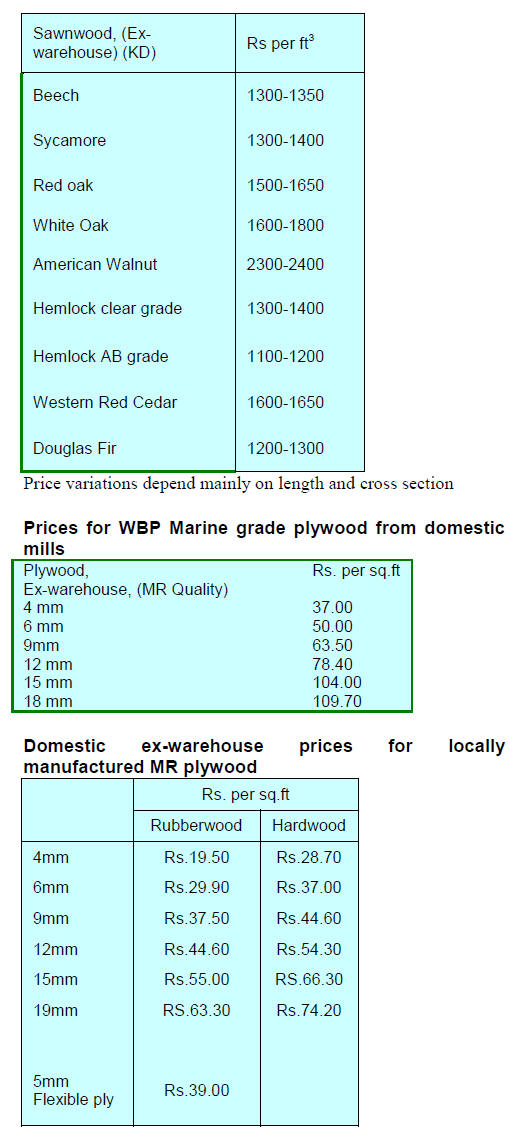
﹛
Plywood manufacturers expect better prices as
investment in housing expands
The allocation of Rs.40 billion made to National Housing
Board by the government for building affordable houses in
urban areas, the Rs.80 billion for rural housing and the
Rs.70.6 billion budget allocation for „smart cities‟ has
lifted sentiment in the plywood industry.
In anticipation of firmer demand plywood manufacturers
are already pushing higher prices.
7.
BRAZIL
Tax on furniture makers unchanged
The Industrialized Products tax (IPI) on furniture,
furniture coatings, panels and some other wood products
will be maintained until December 31, 2014.
As a result of this decision the tax on the furniture industry
will remain at 4% which is a welcome relief as there were
plans for the tax to be increased to 5%.
According to the Furniture Industry Association of Rio
Grande do Sul (MOVERGS) and the Union of Furniture
Industries of Bento Gonçalves (SINDMÓVEIS), the
decision to maintain the tax rate at 4% was good as the
furniture industry is facing difficult times and has high
inventories of unsold furniture, at the same time furniture
imports have been increasing.
IBA wants to expand planted forest area in Brazil
The Brazilian Tree Industry Association (IBÁ) has, since
its inception in April, been very active in the Brazilian
forest sector development. The association is comprised of
73 Brazilian companies with a gross revenue of around R$
60 billion (2013 estimate).
According to IBA, Brazil has the largest planted forest
area in the world and for each hectare of plantation one
hectare of natural forest is preserved. It is forecast, that by
2020, the forest sector will have invested US$53 billion to
double the planted forest area in Brazil.
A great part of these investments should be in the southern
region which today accounts for 20% of total pulp
production, 67% of total wood panel production and 42%
of all paper production.
Exports of tropical plywood and sawnwood rise
In June 2014, the value of wood product exports (except
pulp and paper) fell 2.4% compared to June 2013, from
US$205.6 million to US$200.6 million.
However, pine sawnwood exports increased 34.6% in
value in June 2014 compared to June 2013, from US$13.3
million to US$17.9 million. In terms of volume, exports
rose 32%, from 58,100 cu.m to 76,500 cu.m over the same
period.
In a turnaround from the previous month the volume of
tropical sawnwood exports increased 2.3% from 29,900
cu.m in June 2013 to 30,600 cu.m in June 2014. The value
of exports increased a healthy 6.5% from US$15.5 million
to US$16.5 million, over the same period.
﹛
Exports of pine plywood fell 12% largely because of the
impact of the seasonally weaker markets in the US and
Europe. The value of pine plywood exports in June this
year was US$ 29.1 million down from US$ 33.1 million
in June 2013.
On the other hand exports of tropical plywood, while now
very small, increased 2.3% from 4,300 cu.m in June 2013
to 4,400 cu.m in June 2014. In terms of value, tropical
plywood exports increased 12.5%, from US$2.4 million in
June 2013 to US$2.7 million this June.
Direction of Brazilian sawnwood exports
Brazilian tropical sawnwood exports in June 2014
increased 6.5% in value and 2.2% in volume year on year.
The main destinations (in terms of value) in June 2013
were China, the United States, Vietnam, Belgium and
France representing 15.7%, 14.4%, 13.8%, 7.1% and
5.9%, respectively.
For this June there was a change with the United States
becoming the main importer of Brazilian tropical
sawnwood, (18.8%), followed by China (12.2%), France
(10.6%), the Netherlands (10%) and Vietnam (7.9%).
In terms of total volume, June 2013 tropical sawnwood
exports totalled 29,890 cubic metres while for June this
year exports reached 30,558 cubic metres valued at
US$16.5 million.
The states supplying most of the exports of tropical
sawnwood in terms of value, was Par芍, representing 32%,
followed by Mato Grosso (29%), Rondônia (18%) and
Paran芍 (10%).
Slight increase in first half furniture exports
Despite a rather sharp drop (-7.4%) in wooden furniture
exports in June this year, the first half of 2014 saw
furniture exports increase slightly in value, from US$220
million in the first six months of 2013 to US$223 million
in the same period in 2014.
Last year the main destinations for Brazilian furniture (in
terms of value) in the first six months were the United
States, the United Kingdom, Peru, Chile and Uruguay,
representing 18%, 15%, 8%, 7% and 6.9%, respectively.
This year the pattern of trade remained much the same: the
United States (20%), the United Kingdom (18%), Peru
(8%), Chile (6%) and Uruguay (6%).
The state of Santa Catarina contributed the highest to
furniture exports ( 40%, US$89 million) followed by Rio
Grande do Sul (36%, US$80.4 million) and Paran芍
(15%, US$ 34 million).

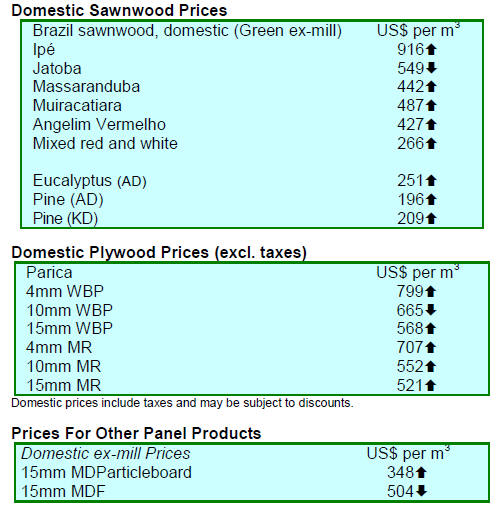
Domestic market prices
Average prices of Brazilian roundwood from natural
forests are ranging from US$ 110/m³ to US$ 184/m³ at
mill yard (US$111 per cubic metre to US$178 in June),
while average prices of Brazilian sawnwood from natural
forests varied from US$ 266/m³ to US$ 916/m³ ex-factory
depending on the species (US$256 per cubic metre to
US$885 in June).
For both cases, highest prices refer to ip那 (Tabebuia sp.)
species, considered noble wood. The average price of
parica WBP glue plywood ranges from US$ 568/m³ to
US$ 799/m³ ex-factory depending on thickness (US$566
per cubic metre to US$768 in June).
Prices for parica MR glue plywood range from US$
521/m³ to US$ 707/m³ ex-factory, according to the
thickness (US$506 per cubic metre to US$684 in June).
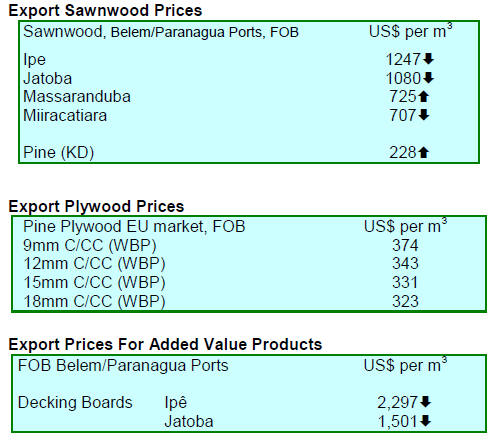
﹛
8. PERU
Package of support for forestry
The Ministry of Agriculture and Irrigation (MINAGRI)
will implement a series of measures to boost forestry in
the country. The package proposed includes the
restructuring of at least ten administrative processes in
order to cut the time taken for authorisations to be
released.
The re-organisation of the procedures will be the
responsibility of the new National Forest Service and
Wildlife (SERFOR) which was officially inaugurated 1
July.
SERFOR Executive Director, Fabiola Muñoz, announced
that implementation of the new forest authority procedures
will result in faster and more efficient processing and full
use will be made of online applications for permits or
licenses.
Wooden furniture exports to reach US$ 8 billion this
year
According to a study by the Center for Business
Intelligence and Markets ( MAXIMIXE) 2014 exports of
wooden furniture will have grown by around 2% and
could total US$8 million on the back of the recovery in the
US housing market.
On the other hand furniture imports could expand 12% in
2014 to US$121 million as demand strengthens in Lima
and the provinces. MAXIMIXE points out that furniture
imports from Brazil and China are growing fast.
Competitively priced imports are having a negative effect
on domestic furniture manufacturers which may see a
decline in domestic sales this year.
Spanish trade mission to Peru
Spanish furniture manufacturers recently toured Peru and
Panama. The companies participating in the trade mission
included Furniture Canella, Point, Mobil Fresno, Brothers
Calatayud and Grassoler Amboan.
The mission was organised by the Asociaci車n Nacional de
Fabricantes y Exportadores de Muebles de España
(ANIEME), in collaboration with the Instituto Español de
Comercio Exterior ( ICEX) to promote trade contacts with
importers and help expand demand in the medium-high
and high-end retail market for Spanish cabinetry in Peru.
ANIEME President, Juan Carlos Muñoz said during a
press conference in Lima that Spanish companies need to
diversify their markets and that there are exciting business
opportunities in Latin American countries such as Peru,
Panama, Mexico, Colombia and Chile.
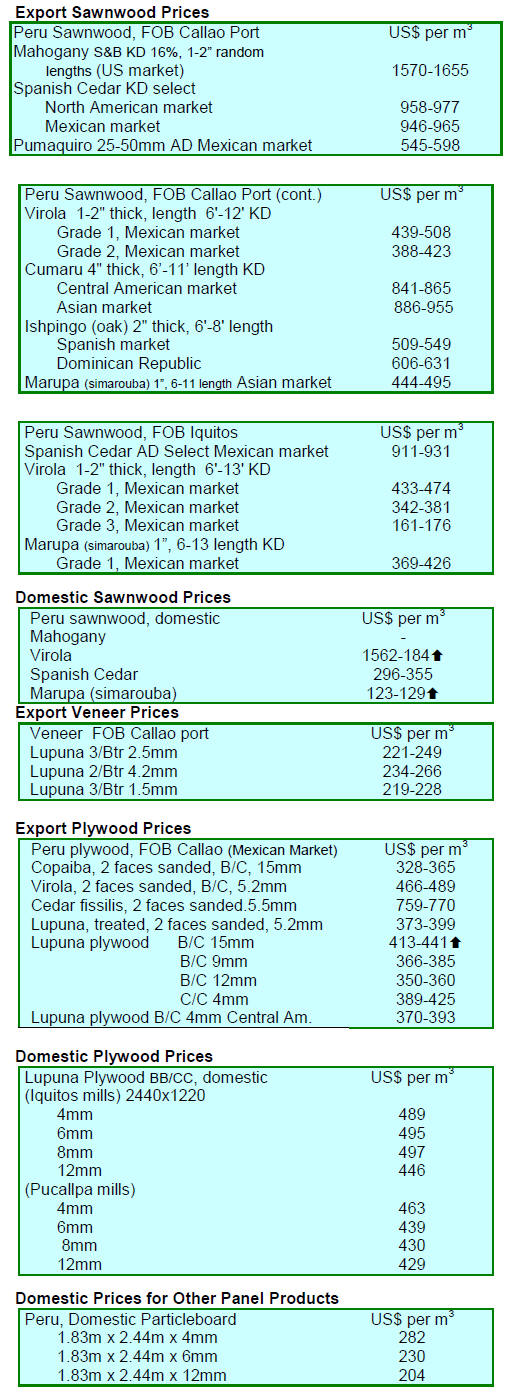
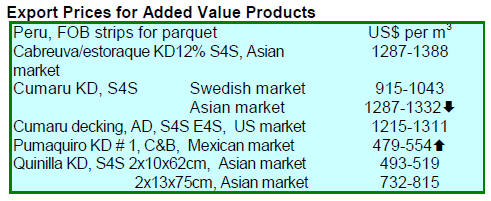
﹛
9.
GUYANA
First quarter exports a year-on-year
improvement
Guyana‟s first quarter 2014 wood product exports totalled
US$8.24 million up 8% on the first quarter 2013 (US$7.6
million). As will be seen from the table below the log and
sawnwood exports accounted for the bulk of export
earnings (90%).
Guyana exports a wide range of products including poles
for transmission lines, foundation piling (manly
greenheart), furniture and builders woodwork, charcoal
craft items.
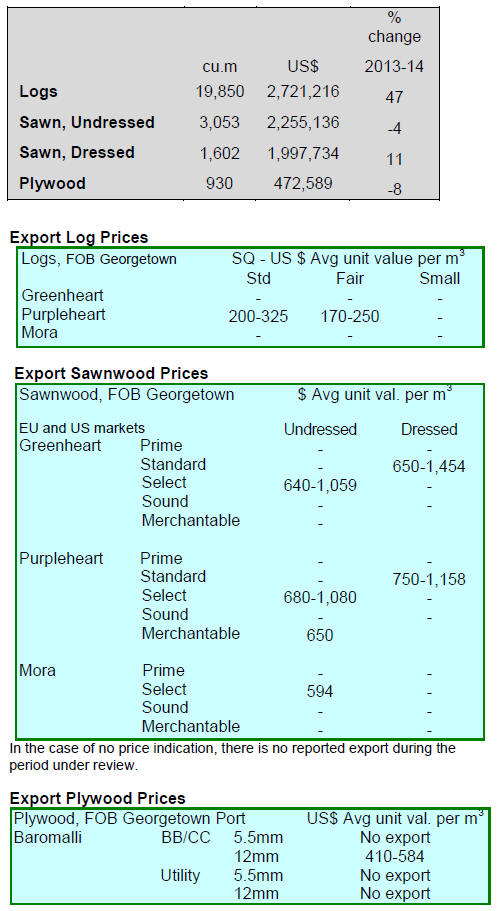
﹛
